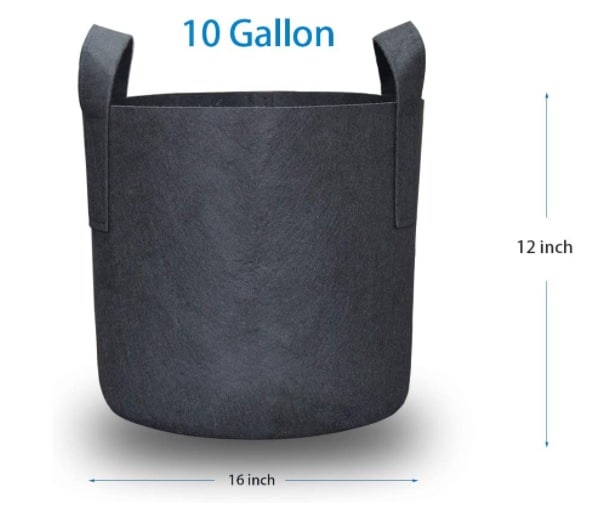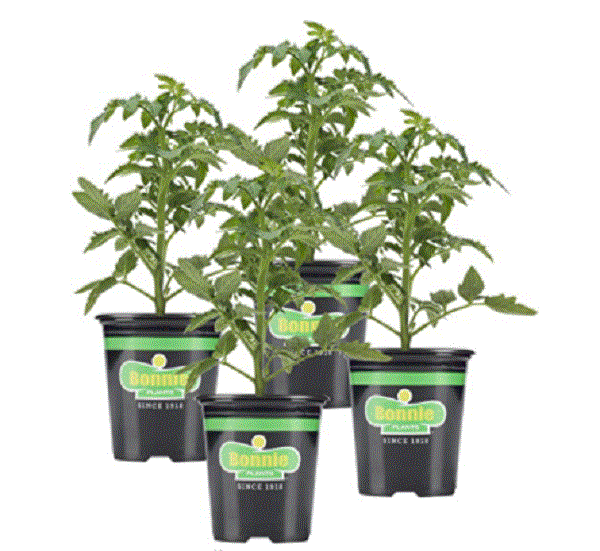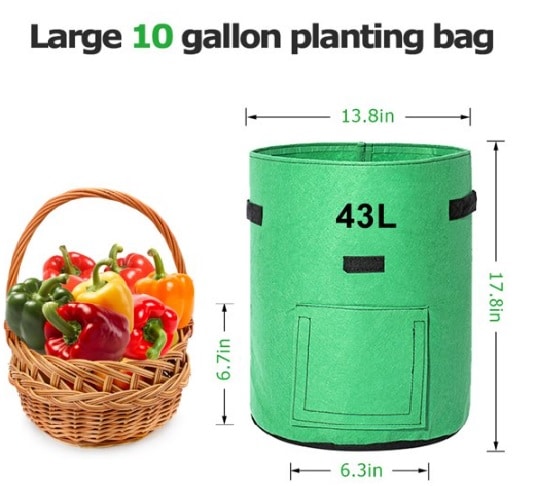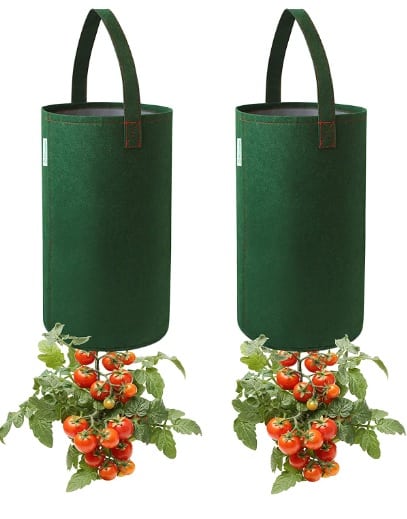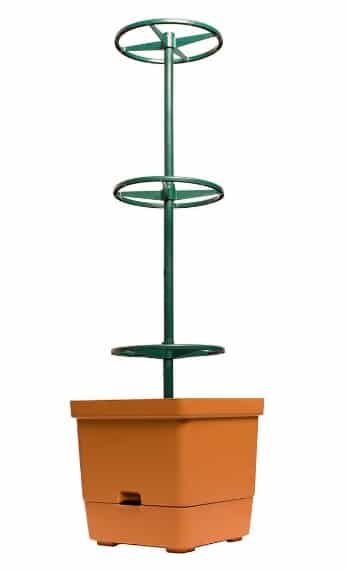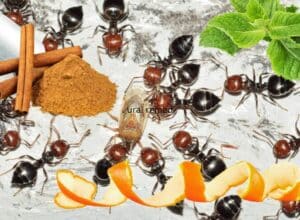Last Updated on March 9, 2024
In short, best grow bags for tomatoes should be at least 15 inch (38cm) in diameter and at least 12 inches (30 cm) deep for healthy tomato growth, which means you should be getting a 10 gallon grow bag or larger for each tomato plant.
You can buy a pack of twelve 10-gallon bags for a very reasonable price on Amazon. These bags work very well for creating a small garden for homeowners with limited outdoor space.
*This post contains affiliate links. If you choose to purchase any of the products I have recommended, I may receive a commission at no cost to you.
Grow bags for tomatoes: how to size them right?
Here is a detailed explanation:
The best sized grow bag for tomatoes will depend on the category and variety of tomato you are going to plant in it:
5 – 7 gallon grow bags can be used for a compact patio tomato variety (like Tiny Tim dwarf cherry tomato, Elfin tear shaped tomato, Window Box Roma or Patio F Hybrid),
10 gallon or larger grow bags fit best for determinate tomato plants,
20 gallon bag and larger will be perfect for indeterminate tomatoes.
Determinate and Indeterminate Tomatoes: what’s the difference?
Indeterminate tomatoes (abbreviation “INDET.”) will grow 5+ feet tall. They usually grow longer vines and need stakes, cages or fencing to support their stems. If you grow this kind of tomatoes in pots or grow bags you can line them along the balcony or fence railings for support.
Indeterminate varieties produce fresh tomato fruit all season long and are an ideal choice for fresh food lovers who want to enjoy tasty succulent tomatoes directly off the vine throughout the season.
Well known indeterminate tomato varieties are: Beefsteak, Better Boy, Big Boy, Big Daddy, Big Mama, heirloom Brandywine, cherry tomato varieties.
Determinate tomatoes (marked in seed catalogs by the abbreviation “DET”) are more compact and often are referred to as “bush” tomatoes. They yield their entire crop all at once, which can be perfect if you want to do all of your harvesting and processing at one time.
Popular determinate tomato varieties include Roma tomatoes, Celebrity, Goliath, Early Girl, Rutgers.
You can get Bonny Plants live tomato plants ready for transplanting into your grow bags right to your door (delivered by Amazon).
Why you shouldn’t use small grow bags for your tomato plants
Please, don’t be tempted to get away with the smaller size grow bag planter.
Technically, you can grow tomatoes even in a 5 gallon bag, but you shouldn’t. A small grow bag will constrict tomato plant roots which leads to poor water and nutrients intake which will lead to smaller tomato yield and subpar taste.
Also, a smaller grow bag will tip over easily with a good burst of wind.
According to PennState extension service, you should go for larger pots when planting tomatoes, because they hold more root mass. Without this mass, the plants will be unable to develop properly and hold enough water to get through the day.
Remember, bigger is better when it comes to growing tomatoes in grow bags or containers.
10 gallon heavy duty planting bags with handles and viewing window (great for root vegetables and potatos). Big, tall and sturdy. A very good investment. Pack of 2. Offered by Walmart.com
You probably also wonder: grow bags good for tomatoes?
And the answer is: yes, they are. Growing tomatoes in grow bags has many pros.
Grow bags advantages:
- Breathable
- Provide good drainage
- Non toxic
- Environmentally friendly
- Easy to use
- Lightweight
- Portable
- Reusable
- Foldable
- Inexpensive
- Longlasting
- Come in many sizes
- Durable
- Easy to clean
Is it better to grow tomatoes in pots or grow bags?
In my opinion it is better to grow tomatoes in grow bags vs containers.
Grow bags are best for tomatoes for the following reasons:
- If you grow tomato plants in a grow bag they will develop a robust root system because of “air pruning.” What does it mean, exactly? When a root reaches the side of the grow bag it comes in contact with drier soil and more air and stops growing. This encourages the plant to make new roots creating a healthy root system with many branching roots that can take in water and nutrients easily. If you grow a tomato plant in a conventional container or pot, when the root touches the side of the planter it starts circling the pot and eventually strangles the plant.
- Tomatoes require frequent watering which can cause drainage problems if you grow tomatoes in containers, because good drainage is hard to achieve in conventional planters. On the contrary, if you grow tomato plants in a grow bag, the excess water will seep into the fabric material and evaporate quickly.
- On a hot summer day tomato plants can get baked in a planter. If you grow tomatoes in a grow bag, the excessive heat is dissipated through the breathable fabric, keeping roots and soil oxygenated and cool throughout the growing season.
- Grow bags are lightweight and portable. As you know, tomato plants need at least 8 hours of sun per day to produce juicy tasty tomatoes. Sometimes you need to move tomato plants to catch needed sun, (or sometimes you need to move them to shade in order to shield plants from excessive heat). Moving your plants is easier when they grow in grow bags in comparison with containers. A grow bag has two handles, it can be lifted by one or two people, or even dragged by pulling a handle. Containers, on the other hand, are heavy to lift or require a caddy on casters for easy maneuverability.
- Grow bags are easy to store at the end of the growing season. Unlike planters, they are compact and take very little storage space.
Upside down tomato grow bags are perfect for growing dwarf cherry tomato varieties or strawberries. These hanging planters are 38 cm high and 22 cm in diameter. Pack of 2. Offered by Amazon
Grow Bags cons
So far, it seems grow bags are the perfect way to grow your tomato plants if you live in a small space and do not have room for a big backyard garden. But, are any drawbacks to these lightweight eco friendly fabric pots?
Sure, there are some disadvantages for growing tomatoes in grow bags.
1 You will need lots of soil to fill your grow bags for growing tomatoes which can be hard on your back and your wallet.
2. Growing tomatoes in a bag can be less successful in comparison with planting tomatoes directly into the ground.
3. It can be tricky to determine how much water tomato plants grown in the bag need. Most people end up overwatering them.
4. Because tomato plants are top heavy, fabric pots with tomatoes are easily tipped over by wind and tossed around in storms. You will need to tie them to deck or balcony rails or think of some sort of other way to secure your grown in the bag tomato plants.
5. If you have a paved concrete patio, you should protect it from discoloration from the grow bags.
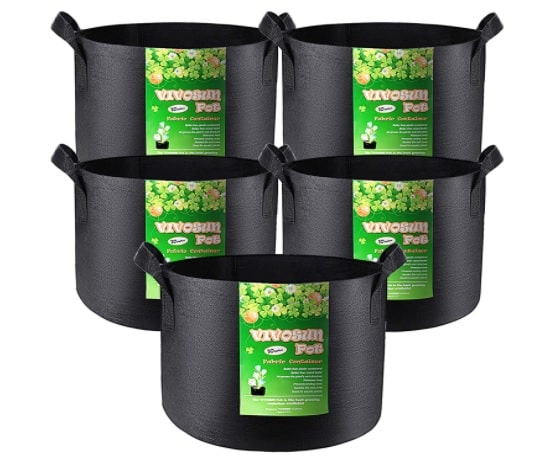
Grow bag dimensions: D19.69″ x H15.75″ (50cm x 40cm).
Do grow bags leach chemicals?
People often wonder: are grow bags toxic? And I understand this concern. As gardeners, we should be aware if plants growing in containers can absorb any harmful chemicals from the material they are made of in order to decide to use these pots or not.
Most grow bags are manufactured from non-woven felt-fabric-like material which is BPA-free polypropylene plastic (PP). Polypropylene is one of the food safe plastics often used for storing food. It’s marked as #5 on containers (in case you forgot, food safe plastics are #1, #2, #4 and #5). If it is safe for storing food, it should be safe for growing it, especially when you are not growing root vegetables but plants that will be harvested above ground (like tomatoes, berries, or leafy greens).
But just to be on the safe side, always check with the manufacturer from which material grow bags are made. If they are made of polypropylene – they are safe to grow your vegetables in.
Best grow bags for tomatoes
I have used lots of fabric pots from Amazon made by different brands: Vivosun, Vigoro, Melon Farm, Jeria, Gardzen, etc. They all seem pretty similar in quality. Their shape (round, square, rectangle), style, color, dimentons vary, so choose what fits most for your space and aesthetics.
I personally prefer black bags, since they show least staining. If you live in a very hot climate though, you might want to avoid black in order not to overheat your tomato plants roots.
Since tomatoes need large size grow bags to grow freely, and you should plant just one tomato per bag, the cost can quickly add up. So, the best budget friendly grow bags for tomatoes to get will be a pack of 12 ten gallon Jaria grow bags. They are well made, highly rated by consumers, yet won’t break the bank.
If you are looking for premium quality grow bags based on brand recognition, then purchase Vivosun grow bags: a pack of five 10 gallon grow bags for determinate tomatoes, or this pack of 20 gallon bags for indeterminate tomato plants.
Grow bag alternative – Hydrofarm tomato tower with support rings. This planter is perfect for easy watering and provides support for your tomato and climbing plants. 3 feet tall. Offered by Amazon.
Tips for growing tomatoes in grow bags, pots and other containers
1 Keep your grow bags in a sunny, bright and well ventilated spot. Your tomato plants should receive at least 8 hours of natural light in the summer.
2. Plant your tomato plant deep to ensure better absorption of the nutrients for your tomato plants to grow faster, stronger, and healthier. (Unlike other plants, tomatoes have the ability to sprout additional roots along the buried stem. So, do not fret about planting them deeply).
3. Since grow bags are so porous and drain fast, they do need more frequent watering. If the weather is hot and your plants have reached maturity, you should water them at least twice per day. Don’t have this kind of time? Think then about installing a drip irrigation system.
Read related: Non toxic soaker garden hose
4. It’s important for your tomato plants to get sufficient amounts of calcium in order to avoid the dreaded blossom end rot. Crushed eggshells are a great way to add more calcium to your soil. Just make sure you clean the empty shells thoroughly before adding them to your garden.
Read related: How to use kitchen scraps to make your soil fertile
5. After your tomato plants start to blossom, feed them with fertilizer rich in potassium for better yield and tastier fruit. (More on the best fertilizer for tomatoes grown in containers later in this article.)
6, Consider getting different varieties of tomatoes plants to guarantee a steady supply of tasty tomatoes all season long
7. In the same bag with your tomato, you can plant basil or compact marigolds for retaining moisture and preventing pests, or maybe even plant some lettuce as a living mulch.
Learn more tips on growing tomatoes in fabric pots from this YouTube video made by The Ripe Tomato Farms:
Best soil for tomatoes in pots
First of all, don’t use soil from your yard or backyard garden in grow bags. Doing this can bring weed seeds, disease pathogens, insects eggs and larvae, etc. In addition, heavy soil from your yard provides poor drainage.
To give your tomato plants in grow bags a good start and optimal growing conditions use a loose, fertile potting soil with good drainage, like this Foxfarm potting soil mix.
It contains many micro nutrients and its ph is adjusted at 6.3 to 6.8 (which is great for tomato plants) to allow for optimum fertilizer uptake.
This soil is perfect for growing tomatoes in non-woven fabric pots, as well as for planting tomatoes in conventional containers indoors and outdoors.
Best fertilizer for tomatoes in pots
If you want your tomato plant to produce juicy flavorful fruit, start to feed them with liquid organic fertilizer two weeks after planting.
Penn state extension service recommends using a balanced 20-20-20 fertilizer until your plants begin flowering.
Best fertilizer for tomato plants in pots once they start flowering should be high in potassium. You can use kelp meal (nutrients ratio is 1- 0.1 – 2) for a nice potassium boost.
Final thoughts on what size grow bag for tomatoes is preferable
When you are buying grow bags for tomatoes it’s important to get them sized just right. Always choose a large grow bag: a minimum of 10 gallons for a determinate tomato plant. Wonder what size grow bag for indeterminate tomatoes? You should choose a 20 gallon to grow bag or larger for indeterminate tomato varieties to give your tomatoes proper room to grow and ensure bumper crop.
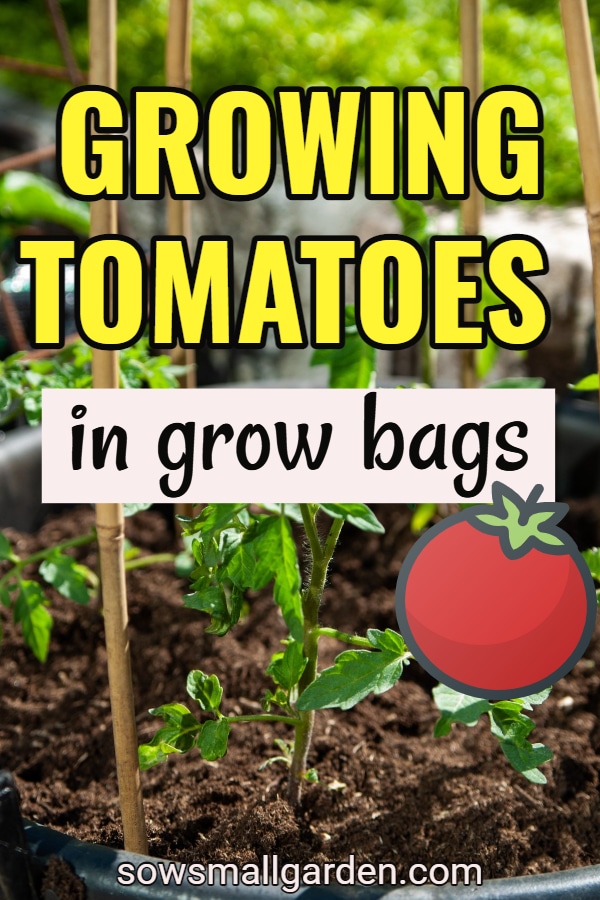
Pin for later reference!
Read related:
Learn more tips and tricks on growing a small garden.
You have read:


